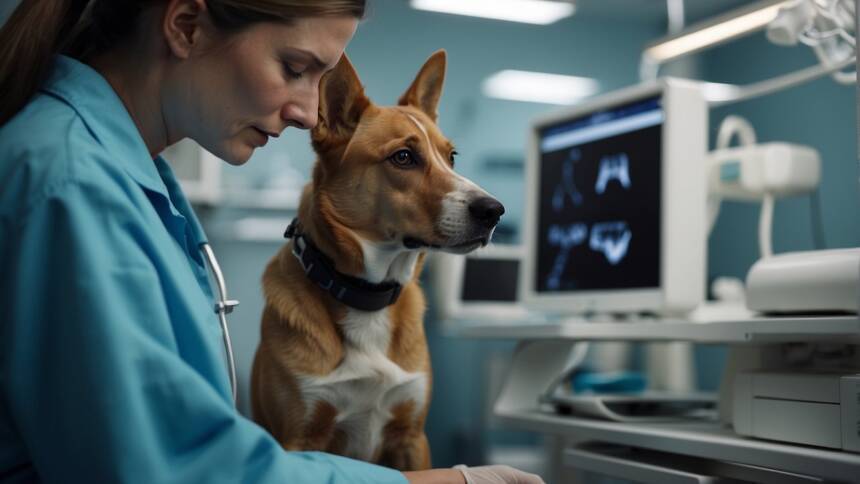When a dog is limping on its back leg, it can be a sign of various underlying issues ranging from minor injuries to more serious health conditions. Limping, or lameness, in dogs can emerge suddenly or develop gradually over time, depending on the cause. It is a visible sign that the dog is experiencing pain, discomfort, or weakness in its limbs.
Causes of back-leg limping in dogs include trauma, such as being hit by a vehicle or a fall, which could lead to fractures, sprains, or ligament tears. Other possible causes might be joint problems like arthritis, hip dysplasia, or other degenerative diseases that can affect dogs as they age. Additionally, issues with tendons or muscles, paw injuries, and even infections can cause a dog to limp.
Owners observing limping should closely monitor their pet for accompanying symptoms like swelling, apparent pain, or an inability to bear weight on the affected leg. These signs help in determining the severity of the condition. Early and accurate diagnosis by a veterinarian ensures proper treatment, which may include anything from rest and medication to surgery, depending on the condition’s cause and severity.
Recognizing the Signs of Limping
When a dog experiences lameness or is limping, it may indicate pain or discomfort in their limbs. Recognizing the signs early can lead to a quicker diagnosis and treatment.
Identifying Limping and Pain in Dogs
A dog may show signs of limping and pain by favoring one leg over another or exhibiting difficulty in standing or walking. They may avoid putting weight on the affected limb. Other indications include:
- Changes in walking patterns, such as hesitancy to walk or an uneven gait
- Visible discomfort when the limb is touched or moved
- Swollen limbs or joints suggesting inflammation or injury
- Altered behavior, such as whimpering or licking the affected area
Observing Gradual Onset Versus Sudden Onset Limping
Gradual onset limping develops over time and can be indicative of chronic conditions such as degenerative diseases. Signs include:
- Progressive reluctance to walk, jump, or play
- Noticeable wasting of muscle on the affected leg
In contrast, sudden onset limps occur abruptly and are often caused by trauma or injury. They present as:
- Immediate lameness after an incident or injury
- Swift changes in usual activity levels, such as an unexpected difficulty with stairs
Common Causes of Leg Limping
Limping in dogs can be symptomatic of various underlying issues, ranging from acute injuries to chronic degenerative conditions that affect the function and structure of the limbs.
Injury-Related Limping in Dogs
When a dog limps due to an injury, it is often the result of:
- Trauma: Sudden lameness may occur following a direct impact or accident that causes fractures or sprains.
- Fractures: Broken bones from falls or high-impact collisions can lead to noticeable limping.
- Sprains: Stretched or torn ligaments, especially in the knee or ankle, can cause pain and difficulty in movement.
Prompt veterinary attention is crucial for these conditions to properly assess the extent of the injury and to initiate appropriate treatment.
Leg and Joint Diseases
Chronic conditions tend to develop over time and can cause limping:
- Arthritis: Inflammation of joints, especially common in older dogs, leading to pain and mobility issues.
- Hip Dysplasia: A genetic malformation of the hip joint, causing pain and arthritis.
- Elbow Dysplasia: Similar to hip dysplasia, affecting the elbows and leading to joint degeneration.
- Osteoarthritis: A progressive form of arthritis marked by cartilage deterioration and joint pain.
Management often requires a combination of medications, weight control, and potentially corrective surgery.
Degenerative Conditions
Some conditions worsen with age, impacting the quality of life:
- Ligament Disease: Conditions like an Anterior Cruciate Ligament (ACL) rupture can cause instability and limping.
- Bone Disease: Diseases such as osteochondrosis can lead to joint inflammation, cartilage damage, and subsequent lameness.
Treatment can range from rest and anti-inflammatory drugs to more advanced surgical options depending on the severity of the disease.
Assessing the Severity of a Dog’s Limp
When a dog exhibits a limp, it is crucial to ascertain the seriousness of the condition. Factors such as swelling, bleeding, and behavioral changes play a pivotal role in determining the severity of the limp. This evaluation will help decide the urgency of veterinary intervention.
Differentiating Between Serious and Minor Limping
Serious Limping:
- Swelling or bleeding: Presence of noticeable swelling or bleeding near a joint or limb suggests a severe issue.
- Non-weight bearing: If the dog completely refuses to bearing weight on the affected leg, it may indicate a serious condition such as a torn ligament.
- Sudden lameness: Acute lameness accompanied by a loud yelp or sudden collapse is often a sign of a serious injury.
Minor Limping:
- Slight stiffness: A subtle limp with some stiffness that improves after the dog warms up can be seen in minor strains.
- Weight-bearing: If the dog can bear some weight on the leg, albeit with discomfort, the cause might be less severe.
- No external signs: In the absence of external signs such as swelling or bleeding, the issue could be minor. However, internal injuries cannot be ruled out solely based on external appearances.
Diagnosis and Veterinary Attention
When a dog presents with limping on its back leg, it is essential to seek veterinary attention to accurately diagnose and address the underlying cause. Proper diagnosis often involves a combination of a thorough physical examination and diagnostic tools, ensuring appropriate treatment.
Importance of a Veterinary Examination
A veterinary examination is critical for a limping dog. The veterinarian will observe the dog’s gait, assess for signs of pain or discomfort, and check for any swelling or abnormalities in the bone or soft tissue. This examination allows the vet to narrow down the possible causes and determine if further diagnostic procedures are needed.
Diagnostic Tools Used by Veterinarians
Veterinarians utilize various diagnostic tools to evaluate a dog’s limping:
- X-rays (Radiographs): These are essential to visualize bone integrity and check for fractures or signs of bone cancer.
- MRI/CT Scans: Advanced imaging can be used when a more detailed view is necessary, particularly for soft tissue evaluation or spinal issues.
A veterinarian’s approach combines these diagnostic tools with a comprehensive physical examination to formulate an effective treatment plan.
Treatment Options and Rehabilitation
When a dog is limping on its back leg, understanding and choosing the right treatment and rehabilitation methods are crucial. These options typically depend on the cause of the lameness, varying from medication management for minor injuries to surgery for more severe conditions.
Medication and Pain Management
For managing pain and inflammation, veterinarians may prescribe anti-inflammatories. These medications help reduce swelling and tenderness, and improve comfort. In cases of joint issues, supplements such as glucosamine may be recommended to support joint health. It’s important to follow the vet’s prescription closely to avoid compromised healing or adverse effects.
Surgical Interventions
Surgery may be required for severe injuries. Conditions such as a dislocated joint, bone fractures, or significant tendon damage often necessitate surgical repair. Post-operative care includes strict rest, with a gradual reintroduction to activity, and potential follow-up surgeries if complications arise.
Physical Therapy and Healing
Following surgery or to manage less severe injuries, physical therapy becomes a key component in a dog’s rehabilitation. Guided exercises to improve range of motion, strengthening exercises, and low-impact activities such as swimming can aid in recovery. Consistency and patience in physical therapy lead to a stronger, more complete recovery.
Home Care and Management
When a pet is experiencing limping due to a back leg injury, owners can take proactive steps at home to manage their pet’s condition. Effective home care focuses on creating a safe environment and ensuring that the dog gets the rest it needs for recovery.
Adapting the Home Environment
Pet owners should modify the home to minimize risks that could exacerbate the injury. Key adaptations include:
- Slip-proofing surfaces: Place non-slip mats or rugs on slippery floors to prevent the dog from losing footing and falling.
- Accessibility: Ensure food, water, and resting areas are easily accessible, avoiding the need for climbing or jumping.
- Stair barriers: Set up baby gates or barriers to prevent the dog from using stairs, as climbing can put additional strain on the injured leg.
Importance of Rest and Restricted Movement
Rest is crucial for healing, and restricting movement can help prevent further injury. Owners should enforce rest by:
- Creating a comfortable rest area: Set up a designated space with soft bedding to encourage the dog to stay put and rest.
- Limiting exercise: Reduce the dog’s activity to short walks for bathroom breaks, and avoid vigorous exercise to aid in the recovery process.
- Monitoring behavior: Watch for signs of improvement or worsening conditions, and adjust the level of activity accordingly.
- Consulting with a vet: Regularly communicate with a veterinarian to assess the need for therapeutic exercises or adjustments in care.
Long-Term Health and Prevention
Ensuring long-term health and preventing limping in a dog’s back leg hinges on attention to joint health and taking preventive measures. These are critical to minimize the impact of aging and to maintain mobility.
Maintaining Joint Health
Joint health is paramount in preventing limping related to the back legs. Aging dogs commonly face deterioration of joint cartilage, which leads to conditions like hip dysplasia—a genetic condition exacerbated by factors such as obesity. To support healthy joints, it’s essential to maintain an appropirate weight through a balanced diet. Regular, moderate exercise is advised to sustain muscle mass, which helps support the joints and contributes to the production of joint fluid.
Preventive Measures for Dog Owners
Dog owners can take active steps to preserve their dog’s mobility and prevent injuries that could lead to limping:
- Regular check-ups: Veterinary visits can help in early detection of conditions that may affect a dog’s mobility.
- Weight management: Preventing obesity reduces stress on the joints and can decrease the likelihood of developing joint-related issues.
- Diet: A nutritious diet rich in omega-3 fatty acids can promote joint health.
- Exercise: Adequate and age-appropriate exercise can strengthen muscles, thus supporting joints and maintaining mobility.
- Genetic screening: For breeds prone to hip dysplasia or other genetic conditions, early genetic screening can inform preventative care strategies.
Through these strategies, dog owners can contribute to the well-being of their pets and potentially reduce the risk of back leg limping as their dogs age.
Recognizing When to Seek Emergency Care
Pet owners should be attuned to signs of serious leg injuries that necessitate immediate veterinary attention. This recognition can help mitigate the severity of the condition and ensure the treatment is timely.
Emergency Symptoms and Immediate Actions
Serious Symptoms Requiring Immediate Care:
If a dog exhibits any of the following symptoms in conjunction with limping, it indicates a situation of high urgency:
- Bleeding: Any sign of blood from the affected limb.
- Abnormal Angulation: A leg that appears at an unnatural angle may suggest a fracture or dislocated joint.
- Swelling and Heat: Excessive swelling or heat in the leg could indicate inflammation or infection.
- Painful Response: A dog that vocalizes intensely or withdraws sharply when the area is touched may have a serious injury.
- Discharge: The presence of pus or unusual discharge from a wound on the leg.
- Immobility: Inability or refusal to stand or walk could imply significant nerve damage or severe internal injury.
Immediate Actions to Take:
- Bleeding Control: Apply pressure to any bleeding wounds.
- Immobilization: Prevent the dog from moving excessively to avoid further injury.
- Transportation: Safely transport the dog to a veterinary clinic or emergency hospital.
Early intervention is key, so when in doubt, it is better to err on the side of caution and consult a veterinarian immediately.








